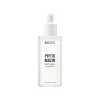What's inside
What's inside
 Key Ingredients
Key Ingredients

 Benefits
Benefits

 Concerns
Concerns

 Ingredients Side-by-side
Ingredients Side-by-side

Water
Skin Conditioning3-O-Ethyl Ascorbic Acid
Skin ConditioningDimethyl Isosorbide
SolventButylene Glycol
HumectantEthoxydiglycol
HumectantSodium Citrate
BufferingCitric Acid
Buffering1,2-Hexanediol
Skin ConditioningSodium Gluconate
Skin ConditioningFerulic Acid
AntimicrobialCoceth-7
EmulsifyingPhenoxyethanol
PreservativePPG-1-PEG-9 Lauryl Glycol Ether
EmulsifyingFullerenes
AntimicrobialTocopheryl Acetate
AntioxidantEthylhexylglycerin
Skin ConditioningPEG-40 Hydrogenated Castor Oil
EmulsifyingPvp
Emulsion StabilisingTrisodium Ethylenediamine Disuccinate
Water, 3-O-Ethyl Ascorbic Acid, Dimethyl Isosorbide, Butylene Glycol, Ethoxydiglycol, Sodium Citrate, Citric Acid, 1,2-Hexanediol, Sodium Gluconate, Ferulic Acid, Coceth-7, Phenoxyethanol, PPG-1-PEG-9 Lauryl Glycol Ether, Fullerenes, Tocopheryl Acetate, Ethylhexylglycerin, PEG-40 Hydrogenated Castor Oil, Pvp, Trisodium Ethylenediamine Disuccinate
Niacinamide
SmoothingLeontopodium Alpinum Extract
Skin ConditioningGentiana Lutea Root Extract
Skin ConditioningPotassium Sorbate
PreservativeAlcohol
AntimicrobialRosa Canina Fruit Extract
AstringentArnica Montana Flower Extract
MaskingSodium Benzoate
MaskingGlycerin
HumectantBambusa Vulgaris Extract
Skin ConditioningAchillea Millefolium Extract
CleansingAcrylates/C10-30 Alkyl Acrylate Crosspolymer
Emulsion StabilisingPotassium Hydroxide
BufferingMorus Alba Bark Extract
Skin ConditioningNelumbo Nucifera Flower Extract
Skin ConditioningButylene Glycol
HumectantArtemisia Absinthium Extract
Skin Conditioning1,2-Hexanediol
Skin ConditioningCitrus Limon Fruit Extract
MaskingSodium Hyaluronate
HumectantDisodium EDTA
Citric Acid
Buffering3-O-Ethyl Ascorbic Acid
Skin ConditioningNiacinamide, Leontopodium Alpinum Extract, Gentiana Lutea Root Extract, Potassium Sorbate, Alcohol, Rosa Canina Fruit Extract, Arnica Montana Flower Extract, Sodium Benzoate, Glycerin, Bambusa Vulgaris Extract, Achillea Millefolium Extract, Acrylates/C10-30 Alkyl Acrylate Crosspolymer, Potassium Hydroxide, Morus Alba Bark Extract, Nelumbo Nucifera Flower Extract, Butylene Glycol, Artemisia Absinthium Extract, 1,2-Hexanediol, Citrus Limon Fruit Extract, Sodium Hyaluronate, Disodium EDTA, Citric Acid, 3-O-Ethyl Ascorbic Acid
 Reviews
Reviews

Ingredients Explained
These ingredients are found in both products.
Ingredients higher up in an ingredient list are typically present in a larger amount.
1,2-Hexanediol is a synthetic liquid and another multi-functional powerhouse.
It is a:
- Humectant, drawing moisture into the skin
- Emollient, helping to soften skin
- Solvent, dispersing and stabilizing formulas
- Preservative booster, enhancing the antimicrobial activity of other preservatives
You might know this ingredient as Ethyl Ascorbic Acid, a more stable version of ascorbic acid.
Like other types of vitamin C, this ingredient has many benefits including reducing wrinkles, skin soothing, dark spot fading, and fighting against free radicals.
3-O-Ethyl Ascorbic Acid interferes with the process of skin darkening, helping to reduce hyperpigmentation. It also encourages the skin to produce more collagen.
Once applied, 3-O-Ethyl Ascorbic Acid is converted to Vitamin C deeper in the skin's layers. This process is slow but makes this ingredient more tolerable for skin.
The optimum pH range for this ingredient is 4 - 5.5
Learn more about 3-O-Ethyl Ascorbic AcidButylene Glycol (or BG) is used within cosmetic products for a few different reasons:
Overall, Butylene Glycol is a safe and well-rounded ingredient that works well with other ingredients.
Though this ingredient works well with most skin types, some people with sensitive skin may experience a reaction such as allergic rashes, closed comedones, or itchiness.
Learn more about Butylene GlycolCitric Acid is an alpha hydroxy acid (AHA) naturally found in citrus fruits like oranges, lemons, and limes.
Like other AHAs, citric acid can exfoliate skin by breaking down the bonds that hold dead skin cells together. This helps reveal smoother and brighter skin underneath.
However, this exfoliating effect only happens at high concentrations (20%) which can be hard to find in cosmetic products.
Due to this, citric acid is usually included in small amounts as a pH adjuster. This helps keep products slightly more acidic and compatible with skin's natural pH.
In skincare formulas, citric acid can:
While it can provide some skin benefits, research shows lactic acid and glycolic acid are generally more effective and less irritating exfoliants.
Most citric acid used in skincare today is made by fermenting sugars (usually from molasses). This synthetic version is identical to the natural citrus form but easier to stabilize and use in formulations.
Read more about some other popular AHA's here:
Learn more about Citric Acid